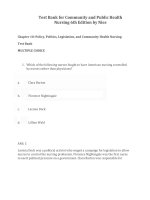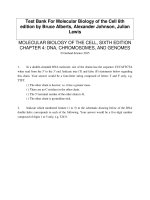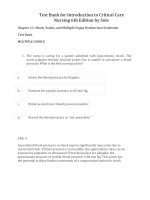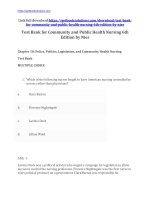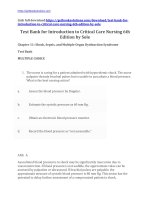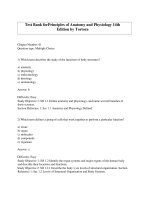Test bank for introduction to critical care nursing 6th edition by sole download
Bạn đang xem bản rút gọn của tài liệu. Xem và tải ngay bản đầy đủ của tài liệu tại đây (737.27 KB, 36 trang )
Test Bank for Introduction to Critical Care
Nursing 6th Edition by Sole
Chapter 11: Shock, Sepsis, and Multiple Organ Dysfunction Syndrome
Test Bank
MULTIPLE CHOICE
1. The nurse is caring for a patient admitted with hypovolemic shock. The
nurse palpates thready brachial pulses but is unable to auscultate a blood
pressure. What is the best nursing action?
a.
Assess the blood pressure by Doppler.
b.
Estimate the systolic pressure as 60 mm Hg.
c.
Obtain an electronic blood pressure monitor.
d.
Record the blood pressure as “not assessable.”
ANS: A
Auscultated blood pressures in shock may be significantly inaccurate due to
vasoconstriction. If blood pressure is not audible, the approximate value can be
assessed by palpation or ultrasound. If brachial pulses are palpable, the
approximate measure of systolic blood pressure is 80 mm Hg. This action has
the potential to delay further assessment of a compromised patient in shock.
Documenting a blood pressure as not assessable is not appropriate without
further attempts using different modalities.
DIF: Cognitive Level: Application
REF: p. 258
OBJ: Develop an individualized plan of care that includes nursing diagnosis,
expected outcomes, nursing interventions, and rationales.
TOP: Nursing
Process Step: Assessment
MSC: NCLEX: Physiological Integrity: Reduction of Risk Potential
2. The nurse has just completed an infusion of a 1000 mL bolus of 0.9% normal
saline in a patient with severe sepsis. One hour later, which laboratory
result requires immediate nursing action?
a.
Creatinine 1.0 mg/dL
b.
Lactate 6 mmol/L
c.
Potassium 3.8 mEq/L
d.
Sodium 140 mEq/L
ANS: B
Lactate level has been used as an indicator of decreased oxygen delivery to the
cells, adequacy of resuscitation in shock, and as an outcome predictor. All other
listed values are within normal limits and do not require additional follow-up.
DIF: Cognitive Level: Application
REF: p. 259 | Laboratory Alert
OBJ: Relate assessment findings to the classification and stage of shock.
TOP: Nursing Process Step: Assessment
MSC: NCLEX: Physiological Integrity: Reduction of Risk Potential
3. The nurse has been administering 0.9% normal saline intravenous fluids as
part of early goal-directed therapy protocols in a patient with severe sepsis.
To evaluate the effectiveness of fluid therapy, which physiological
parameters would be most important for the nurse to assess?
a.
Breath sounds and capillary refill
b.
Blood pressure and oral temperature
c.
Oral temperature and capillary refill
d.
Right atrial pressure and urine output
ANS: D
Early goal-directed therapy includes administration of IV fluids to keep central venous
pressure at 8 mm Hg or greater. Combined with urine output, fluid therapy
effectiveness can be adequately assessed. Evaluation of breath sounds assists with
determining fluid overload in a patient but does not evaluate the effectiveness of fluid
therapy. Capillary refill provides a quick assessment of the patient’s overall
cardiovascular status, but this assessment is not reliable in a patient who is
hypothermic or has peripheral circulatory problems. Evaluation of oral temperature
does not assess the effectiveness of fluid therapy in patients in shock. Evaluation of oral
temperature does not assess the effectiveness of fluid therapy in patients in
shock. Capillary refill provides a quick assessment of the patient’s overall
cardiovascular status, but this assessment is not reliable in a patient who
is hypothermic or has peripheral circulatory problems.
DIF: Cognitive Level: Application
REF: p. 282
OBJ: Describe management strategies for each classification of shock.
TOP: Nursing Process Step: Assessment
MSC: NCLEX: Physiological Integrity: Pharmacological and Parenteral Therapies
4. A patient is admitted to the critical care unit following coronary artery bypass
surgery. Two hours postoperatively, the nurse assesses the following
information: pulse is 120 beats/min; blood pressure is 70/50 mm Hg;
pulmonary artery diastolic pressure is 2 mm Hg; cardiac output is 4 L/min;
urine output is 250 mL/hr; chest drainage is 200 mL/hr. What is the best
interpretation by the nurse?
a.
The assessed values are within normal limits.
b.
The patient is at risk for developing cardiogenic shock.
c.
The patient is at risk for developing fluid volume
overload.
d.
The patient is at risk for developing
hypovolemic shock.
ANS: D
Vital signs and hemodynamic values assessed collectively include classic signs and
symptoms of hypovolemia. Both urine output and chest drainage values are high,
contributing to the hypovolemia. Assessed values are not within normal limits.
A cardiac output of 4 L/min is not indicative of cardiogenic shock. The patient is at
risk for hypovolemia, not volume overload, as evidenced by excessive hourly chest
drainage and urine output.
DIF: Cognitive Level: Analysis
REF: p. 270 | Table 11-5
OBJ: Relate assessment findings to the classification and stage of shock.
TOP: Nursing Process Step: Assessment
MSC: NCLEX: Physiological Integrity: Reduction of Risk
5. A patient is admitted after collapsing at the end of a summer marathon. She
is lethargic, with a heart rate of 110 beats/min, respiratory rate of 30
breaths/min, and a blood pressure of 78/46 mm Hg. The nurse anticipates
administering which therapeutic intervention?
a.
Human albumin infusion
b.
Hypotonic saline solution
c.
Lactated Ringer’s bolus
d.
Packed red blood cells
ANS: C
The patient is experiencing symptoms of hypovolemic shock. Isotonic crystalloids,
such as normal saline and lactated Ringer’s solutions, are the priority intervention.
Albumin and plasma protein fraction (Plasmanate) are naturally occurring colloid
solutions that are infused when the volume loss is caused by a loss of plasma rather
than blood, such as in burns, peritonitis, and bowel obstruction. Hypotonic solutions
rapidly leave the intravascular space, causing interstitial and intracellular edema
and are not used for fluid resuscitation. There is no evidence to support a
transfusion in the given scenario.
DIF: Cognitive Level: Analysis
REF: p. 270 | Table 11-5
OBJ: Describe management strategies for each classification of shock.
TOP: Nursing Process Step: Intervention
MSC: NCLEX: Physiological Integrity: Pharmacological and Parenteral Therapies
6. The nurse is caring for a patient in the early stages of septic shock. The
patient is slightly confused and flushed, with bounding peripheral pulses.
Which hemodynamic values is the nurse most likely to assess?
a.
High pulmonary artery occlusive pressure and
high cardiac output
b.
High systemic vascular resistance and low cardiac
output
c.
Low pulmonary artery occlusive pressure and
low cardiac output
d.
Low systemic vascular resistance and high cardiac
output
ANS: D
As a consequence of the massive vasodilation associated with septic shock, in the
early stages, cardiac output is high with low systemic vascular resistance. In
septic shock, pulmonary artery occlusion pressure is not elevated. In the early
stages of septic shock, systemic vascular resistance is low and cardiac output is
high. In the early stages of septic shock, cardiac output is high.
DIF: Cognitive Level: Knowledge
REF: p. 270 | Table 11-5
OBJ: Relate assessment findings to the classification and stage of shock.
TOP: Nursing Process Step: Assessment
MSC: NCLEX: Physiological Integrity: Physiological Adaptation
7. The nurse is caring for a patient admitted with severe sepsis. Vital signs
assessed by the nurse include blood pressure 80/50 mm Hg, heart rate
120 beats/min, respirations 28 breaths/min, oral temperature of 102° F,
and a right atrial pressure (RAP) of 1 mm Hg. Assuming physician orders,
which intervention should the nurse carry out first?
a.
Acetaminophen suppository
b.
Blood cultures from two sites
c.
IV antibiotic administration
d.
Isotonic fluid challenge
ANS: D
Early goal-directed therapy in severe sepsis includes administration of IV fluids
to keep RAP/CVP at 8 mm Hg or greater (but not greater than 15 mm Hg) and
heart rate less than 110 beats/min. Fluid resuscitation to restore pe������������������������������������������������������������������������������������������������������������������������������������������������������������������������������������������������������������������������������������������������������������������������������������������������������������������������������������������������������������������������������������������������������������������������������������������������������������������������������������������������������������������������������������������������������������������������������������������������������������������������������������������������������������������������������������������������������������������������������������������������������������������������������������������������������������������������������������������������������������������������������������������������������������������������������������������������������������������������������������������������������������������������������������������������������������������������������������������������������������������������������������������������������������������������������������������������������������������������������������������������������������������������������������������������������������������������������������������������������������������������������������������������������������������������������������������������������������������������������������������������������������������������������������������������������������������������������������������������������������������������������������������������������������������������������������������������������������������������������������������������������������������������������������������������������������������������������������������������������������������������������������������������������������������������������������������������������������������������������������������������������������������������������������������������������������������������������������������������������������������������������������������������������������������������������������������������������������������������������������������������������������������������������������������������������������������������������������������������������������������������������������������������������������������������������������������������������������������������������������������������������������������������������������������������������������������������������������������������������������������������������������������������������������������������������������������������������������������������������������������������������������������������������������������������������������������������������������������������������������������������������������������������������������������������������������������������������������������������������������������������������������������������������������������������������������������������������������������������������������������������������������������������������������������������������������������������������������������������������������������������������������������������������������������������������������������������������������������������������������������������������������������������������������������������������������������������������������������������������������������������������������������������������������������������������������������������������������������������������������������������������������������������������������������������������������������������������������������������������������������������������������������������������������������������������������������������������������������������������������������������������������������������������������������������������������������������������������������������������������������������������������������������������������������������������������������������������������������������������������������������������������������������������������������������������������������������������������������������������������������������������������������������������������������������������������������������������������������������������������������������������������������������������������������������������������������������������������������������������������������������������������������������������������������������������������������������������������������������������������������������������������������������������������������������������������������������������������������������������������������������������������������������������������������������������������������������������������������������������������������������������������������������������������������������������������������������������������������������������������������������������������������������������������������������������������������������������������������������������������������������������������������������������������������������������������������������������������������������������������������������������������������������������������������������������������������������������������������������������������������������������������������������������������������������������������������������������������������������������������������������������������������������������������������������������������������������������������������������������������������������������������������������������������������������������������������������������������������������������������������������������������������������������������������������������������������������������������������������������������������������������������������������������������������������������������������������������������������������������������������������������������������������������������������������������������������������������������������������������������������������������������������������������������������������������������������������������������������������������������������������������������������������������������������������������������������������������������������������������������������������������������������������������������������������������������������������������������������������������������������������������������������������������������������������������������������������������������������������������������������������������������������������������������������������������������������������������������������������������������������������������������������������������������������������������������������������������������������������������������������������������������������������������������������������������������������������������������������������������������������������������������������������������������������������������������������������������������������������������������������������������������������������������������������������������������������������������������������������������������������������������������������������������������������������������������������������������������������������������������������������������������������������������������������������������������������������������������������������������������������������������������������������������������������������������������������������������������������������������������������������������������������������������������������������������������������������������������������������������������������������������������������������������������������������������������������������������������������������������������������������������������������������������������������������������������������������������������������������������������������������������������������������������������������������������������������������������������������������������������������������������������������������������������������������������������������������������������������������������������������������������������������������������������������������������������������������������������������������������������������������������������������������������������������������������������������������������������������������������������������������������������������������������������������������������������������������������������������������������������������������������������������������������������������������������������������������������������������������������������������������������������������������������������������������������������������������������������������������������������������������������������������������������������������������������������������������������������������������������������������������������������������������������������������������������������������������������������������������������������������������������������������������������������������������������������������������������������������������������������������������������������������������������������������������������������������������������������������������������������������������������������������������������������������������������������������������������������������������������������������������������������������������������������������������������������������������������������������������������������������������������������������������������������������������������������������������������������������������������������������������������������������������������������������������������������������������������������������������������������������������������������������������������������������������������������������������������������������������������������������������������������������������������������������������������������������������������������������������������������������������������������������������������������������������������������������������������������������������������������������������������������������������������������������������������������������������������������������������������������������������������������������������������������������������������������������������������������������������������������������������������������������������������������������������������������������������������������������������������������������������������������������������������������������������������������������������������������������������������������������������������������������������������������������������������������������������������������������������������������������������������������������������������������������������������������������������������������������������������������������������������������������������������������������������������������������������������������������������������������������������������������������������������������������������������������������������������������������������������������������������������������������������������������������������������������������������������������������������������������������������������������������������������������������������������������������������������������������������������������������������������������������������������������������������������������������������������������������������������������������������������������������������������������������������������������������������������������������������������������������������������������������������������������������������������������������������������������������������������������������������������������������������������������������������������������������������������������������������������������������������������������������������������������������������������������������������������������������������������������������������������������������������������������������������������������������������������������������������������������������������������������������������������������������������������������������������������������������������������������������������������������������������������������������������������������������������������������������������������������������������������������������������������������������������������������������������������������������������������������������������������������������������������������������������������������������������������������������������������������������������������������������������������������������������������������������������������������������������������������������������������������������������������������������������������������������������������������������������������������������������������������������������������������������������������������������������������������������������������������������������������������������������������������������������������������������������������������������������������������������������������������������������������������������������������������������������������������������������������������������������������������������������������������������������������������������������������������������������������������������������������������������������������������������������������������������������������������������������������������������������������������������������������������������������������������������������������������������������������������������������������������������������������������������������������������������������������������������������������������������������������������������������������������������������������������������������������������������������������������������������������������������������������������������������������������������������������������������������������������������������������������������������������������������������������������������������������������������������������������������������������������������������������������������������������������������������������������������������������������������������������������������������������������������������������������������������������������������������������������������������������������������������������������������������������������������������������������������������������������������������������������������������������������������������������������������������������������������������������������������������������������������������������������������������������������������������������������������������������������������������������������������������������������������������������������������������������������������������������������������������������������������������������������������������������������������������������������������������������������������������������������������������������������������������������������������������������������������������������������������������������������������������������������������������������������������������������������������������������������������������������������������������������������������������������������������������������������������������������������������������������������������������������������������������������������������������������������������������������������������������������������������������������������������������������������������������������������������������������������������������������������������������������������������������������������������������������������������������������������������������������������������������������������������������������������������������������������������������������������������������������������������������������������������������������������������������������������������������������������������������������������������������������������������������������������������������������������������������������������������������������������������������������������������������������������������������������������������������������������������������������������������������������������������������������������������������������������������������������������������������������������������������������������������������������������������������������������������������������������������������������������������������������������������������������������������������������������������������������������������������������������������������������������������������������������������������������������������������������������������������������������������������������������������������������������������������������������������������������������������������������������������������������������������������������������������������������������������������������������������������������������������������������������������������������������������������������������������������������������������������������������������������������������������������������������������������������������������������������������������������������������������������������������������������������������������������������������������������������������������������������������������������������������������������������������������������������������������������������������������������������������������������������������������������������������������������������������������������������������������������������������������������������������������������������������������������������������������������������������������������������������������������������������������������������������������������������������������������������������������������������������������������������������������������������������������������������������������������������������������������������������������������������������������������������������������������������������������������������������������������������������������������������������������������������������������������������������������������������������������������������������������������������������������������������������������������������������������������������������������������������������������������������������������������������������������������������������������������������������������������������������������������������������������������������������������������������������������������������������������������������������������������������������������������������������������������������������������������������������������������������������������������������������������������������������������������������������������������������������������������������������������������������������������������������������������������������������������������������������������������������������������������������������������������������������������������������������������������������������������������������������������������������������������������������������������������������������������������������������������������������������������������������������������������������������������������������������������������������������������������������������������������������������������������������������������������������������������������������������������������������������������������������������������������������������������������������������������������������������������������������������������������������������������������������������������������������������������������������������������������������������������������������������������������������������������������������������������������������������������������������������������������������������������������������������������������������������������������������������������������������������������������������������������������������������������������������������������������������������������������������������������������������������������������������������������������������������������������������������������������������������������������������������������������������������������������������������������������������������������������������������������������������������������������������������������������������������������������������������������������������������������������������������������������������������������������������������������������������������������������������������������������������������������������������������������������������������������������������������������������������������������������������������������������������������������������������������������������������������������������������������������������������������������������������������������������������������������������������������������������������������������������������������������������������������������������������������������������������������������������������������������������������������������������������������������������������������������������������������������������������������������������������������������������������������������������������������������������������������������������������������������������������������������������������������������������������������������������������������������������������������������������������������������������������������������������������������������������������������������������������������������������������������������������������������������������������������������������������������������������������������������������������������������������������������������������������������������������������������������������������������������������������������������������������������������������������������������������������������������������������������������������������������������������������������������������������������������������������������������������������������������������������������������������������������������������������������������������������������������������������������������������������������������������������������������������������������������������������������������������������������������������������������������������������������������������������������������������������������������������������������������������������������������������������������������������������������������������������������������������������������������������������������������������������������������������������������������������������������������������������������������������������������������������������������������������������������������������������������������������������������������������������������������������������������������������������������������������������������������������������������������������������������������������������������������������������������������������������������������������������������������������������������������������������������������������������������������������������������������������������������������������������������������������������������������������������������������������������������������������������������������������������������������������������������������������������������������������������������������������������������������������������������������������������������������������������������������������������������������������������������������������������������������������������������������������������������������������������������������������������������������������������������������������������������������������������������������������������������������������������������������������������������������������������������������������������������������������������������������������������������������������������������������������������������������������������������������������������������������������������������������������������������������������������������������������������������������������������������������������������������������������������������������������������������������������������������������������������������������������������������������������������������������������������������������������������������������������������������������������������������������������������������������������������������������������������������������������������������������������������������������������������������������������������������������������������������������������������������������������������������������������������������������������������������������������������������������������������������������������������������������������������������������������������������������������������������������������������������������������������������������������������������������������������������������������������������������������������������������������������������������������������������������������������������������������������������������������������������������������������������������������������������������������������������������������������������������������������������������������������������������������������������������������������������������������������������������������otor vehicle crash.
Over the past 2 hours, the patient has received 6 units of packed red blood
cells and 4 units of fresh frozen plasma by rapid infusion. To prevent
complications, what is the priority nursing intervention?
a.
Administer pain medication.
b.
Turn patient every 2 hours.
c.
Assess core body temperature.
d.
Apply bilateral heel protectors.
ANS: C
Hypothermia is anticipated during the rapid infusion of fluids or blood products.
Assessment of core body temperature is a priority. While administration of pain
management, repositioning the patient every 2 hours, and application of heel
protectors should be part of the patient care, given the rapid transfusion of
blood products, these interventions are not the priority in this scenario.
DIF: Cognitive Level: Application
REF: pp. 267-268
OBJ: Develop an individualized plan of care that includes nursing diagnosis,
expected outcomes, nursing interventions, and rationales.
TOP: Nursing
Process Step: Assessment
MSC: NCLEX: Physiological Integrity: Reduction of Risk
30. The nurse is caring for a patient in cardiogenic shock who is being treated
with an infusion of dobutamine (Dobutrex). The physician’s order calls for
the nurse to titrate the infusion to achieve a cardiac index of >2.5 L/min/m2.
The nurse measures a cardiac output, and the calculated cardiac index for the
patient is 4.6 L/min/m2. What is the best action by the nurse?
a.
Obtain a stat serum potassium level.
b.
Order a stat 12-lead electrocardiogram.
c.
Reduce the rate of dobutamine (Dobutrex).
d.
Assess the patient’s hourly urine output.
ANS: C
Dobutamine (Dobutrex) is used to stimulate contractility and heart rate while
causing vasodilation in low cardiac output states improving overall cardiac
performance. The patient’s cardiac index is well above normal limits, so the rate of
infusion of the medication should be reduced so as not to overstimulate the heart.
There is no evidence to support the need for a serum potassium or 12-lead
electrocardiogram. Assessment of hourly urine output is important in the care of the
patient in cardiogenic shock, but it is not a priority in this scenario.
DIF: Cognitive Level: Analysis
REF: p. 265
OBJ: Develop an individualized plan of care that includes nursing diagnosis,
expected outcomes, nursing interventions, and rationales.
TOP: Nursing
Process Step: Assessment
MSC: NCLEX: Physiological Integrity: Pharmacological and Parenteral Therapies
31. After receiving a handoff report from the night shift, the nurse completes
the morning assessment of a patient with severe sepsis. Vital sign
assessment notes blood pressure 95/60 mm Hg, heart rate 110 beats/min,
respirations 32 breaths/min, oxygen saturation (SpO2) 96% on 45% oxygen
via Venturi mask, temperature 101.5° F, central venous pressure (CVP/RAP)
2 mm Hg, and urine output of 10 mL for the past hour. The nurse initiates
which active physician order first?
a.
Administer infusion of 500 mL 0.9% normal saline
every 4 hours as needed if the CVP is < 5 mm Hg.
b.
Increase supplemental oxygen therapy to maintain
SpO2greater than 94%.
c.
Administer 40 mg furosemide (Lasix) intravenous as
needed if the urine output is less than 30 mL/hr.
d.
Administer acetaminophen (Tylenol) 650-mg
suppository per rectum as needed to treat
temperature > 101° F.
ANS: A
Fluid volume resuscitation is the priority in patients with severe sepsis to maintain
circulating blood volume and end-organ perfusion and oxygenation. A 500-mL IV
bolus of 0.9% normal saline is appropriate given the patient’s CVP of 2 mm Hg and
hourly urine output of 10 mL/hr. There is no evidence to support the need to
increase supplemental oxygen. Administration of furosemide (Lasix) in the presence
of a fluid volume deficit is contraindicated.
DIF: Cognitive Level: Analysis
REF: p. 262
OBJ: Develop an individualized plan of care that includes nursing diagnosis,
expected outcomes, nursing interventions, and rationales.
TOP: Nursing
Process Step: Assessment
MSC: NCLEX: Physiological Integrity: Physiological Adaptation
32. The nurse is caring for a patient with severe sepsis who was resuscitated
with 3000 mL of lactated Ringer solution over the past 4 hours. Morning
laboratory results show a hemoglobin of 8 g/dL and hematocrit of 28%. What
is the best interpretation of these findings by the nurse?
a.
Blood transfusion with packed red blood cells is
required.
b.
Hemoglobin and hematocrit results indicate
hemodilution.
c.
Fluid resuscitation has resulted in fluid volume
overload.
d.
Fluid resuscitation has resulted in third spacing of
fluid.
ANS: B
Fluid resuscitation with large volumes of crystalloid results in hemodilution of red
blood cells and plasma proteins. Hemoglobin and hematocrit results indicate
hemodilution. Given the clinical scenario, there is no evidence to support the need
for a blood transfusion and no evidence of fluid overload. Although administration
of large volumes of crystalloid can result in hemodilution of plasma proteins
leading to third spacing of fluid, this fact does not support the hemoglobin and
hematocrit results.
DIF: Cognitive Level: Comprehension REF: p. 260
OBJ: Develop an individualized plan of care that includes nursing diagnosis,
expected outcomes, nursing interventions, and rationales.
TOP: Nursing
Process Step: Evaluation
MSC: NCLEX: Physiological Integrity: Reduction of Risk
MULTIPLE RESPONSE
1. Fifteen minutes after beginning a transfusion of O negative blood to a patient
in shock, the nurse assesses a drop in the patient’s blood pressure to 60/40
mm Hg, heart rate 135 beats/min, respirations 40 breaths/min, and a
temperature of 102° F. The nurse notes the new onset of hematuria in the
patient’s Foley catheter. What are the priority nursing actions? (Select all that
apply.)
a.
Administer acetaminophen (Tylenol).
b.
Document the patient’s response.
c.
Increase the rate of transfusion.
d.
Notify the blood bank.
e.
Notify the physician.
f.
Stop the transfusion.
ANS: B, D, E, F
In the event of a reaction, the transfusion is stopped, the patient is assessed, and
both the physician and laboratory are notified. All transfusion equipment (bag,
tubing, and remaining solutions) and any blood or urine specimens obtained are
sent to the laboratory according to hospital policy. The events of the reaction,
interventions used, and patient response to treatment are documented.
Acetaminophen is not warranted in the immediate recognition and treatment of a
transfusion reaction. The infusion must be stopped. Increasing the infusion
further increases the likelihood of worsening the transfusion reaction.
DIF: Cognitive Level: Analysis
REF: p. 278
OBJ: Describe management strategies for each classification of shock.
TOP: Nursing Process Step: Intervention MSC: NCLEX: Physiological Integrity
2. The nurse is caring for a young adult patient admitted with shock. The
nurse understands which assessment findings best assess tissue perfusion
in a patient in shock? (Select all that apply.)
a.
Blood pressure
b.
Heart rate
c.
Level of consciousness
d.
Pupil response
e.
Respirations
f.
Urine output
ANS: A, C, F
The level of consciousness assesses cerebral perfusion, urine output assesses
renal perfusion, and blood pressure is a general indicator of systemic perfusion.
Heart rate is not an indicator of perfusion. Pupillary response does not assess
perfusion. Respirations do not assess perfusion.
DIF: Cognitive Level: Analysis
REF: p. 257 | Clinical Alert
OBJ: Relate assessment findings to the classification and stage of shock.
TOP: Nursing Process Step: Assessment MSC: NCLEX: Physiological Integrity


